|
Travelogue Menu

MAY 29, 2002
An Interview with Kanzaki Shiho
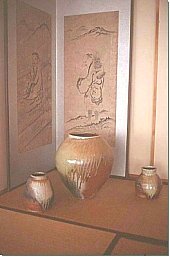
Shigaraki-yaki in Kanzaki's Showroom
Northwest Airlines Flight #69 descended into Osaka, and I was returning to Japan once again. Even though I am a foreigner here, this place has been full of friendship and learning for me. My visits, over the past 10 years, have enriched my life and widened my understandings. But more than anything else, my times in Japan have prompted deep ponderings, and have raised questions for my consideration -- questions I may never have encountered anywhere else.
This trip was a little different from previous visits. Two writing projects prompted my travel -- some work as technical editor for the Furutani Michio text Anagama: Building Kilns and Firing (now being translated into English), and work on an article I'm writing that focuses on interviews with three generations of Masters and Apprentices within the Japanese apprenticeship tradition.
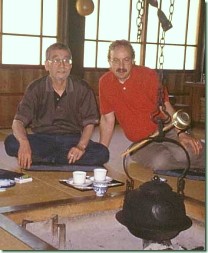 My first stop was a visit with my friend Kanzaki Shiho, who lives in Shigaraki. There I met with and interviewed Kanzaki sensei. Later I interviewed his Master, Matsuyama Suketoshi, and Kanzaki's now-independent Apprentice Matsukawa Hiromi -- all in an effort to learn more about the Master/Apprentice system in Japan. My first stop was a visit with my friend Kanzaki Shiho, who lives in Shigaraki. There I met with and interviewed Kanzaki sensei. Later I interviewed his Master, Matsuyama Suketoshi, and Kanzaki's now-independent Apprentice Matsukawa Hiromi -- all in an effort to learn more about the Master/Apprentice system in Japan.
"Work" was interspersed with visits to the Miho Museum and the Shigaraki Cultural Park, travel to Tamba to visit friends, and later a trip up to the Eichizen coast in search of area pots, beautiful sunsets, and giant (delicious) crabs.
It would be impossible to condense my hours of interviews with Kanzaki-san. But I'd like to tell you about just one aspect of the discussion. Kanzaki and I had a conversation about how he continues to learn -- and how he (as a Master) teaches.
In the early stages of learning, says Kanzaki, there might be the need for inspiration that comes from outside of oneself. When he was much younger, he would sometimes begin "intentional learning" by examining pots, or images of pots, that he found interesting. He said that he tried to look only at the things that were most stimulating to him. And then, he would view a single piece continually for two days. If, after two days of constant looking, he was still fascinated with the piece, he would measure it as a piece worth learning from.
After this initial "concentrated" looking, Kanzaki would not look at the piece for at least one year. (And he would not try to make a piece that was inspired by this piece for at least a year.) Instead he would let the image of the work, and his own imagination, begin to mature in his mind. He describes this process as "chasing the image." The image began to change as it integrated into Kanzaki's heart and soul and spirit. As the image changed, Kanzaki continued to chase it. Over time, it became his own -- not so much resembling the initial form, but having been distilled into something of the spirit of the initial piece -- having been flavored by his own spirit. And thereafter, as the making began, the chase continued. The works themselves began to inspire a new round of chasing. "It is a matter of making works according to my own mind and heart and spirit," Kanzaki emphasized. "If you are a ceramic artist, all your life and spirit and self can be explained through your work."
"But how do you teach your apprentices to make these kinds of works," I asked.
In response, Kanzaki says he never demonstrates the making process for his apprentice, nor do they ever watch him actually make the pots. "Why?" I wondered aloud. "How can this be good teaching?" I pondered.
"If I show them how to make a chawan, maybe my apprentices will always be only tracing my work. Maybe they will not be making works that come from their own heart and spirit. Sometimes my apprentices ask me, 'How do you do that?' Sometimes I say, 'I don't know.' In this way I help them discover for themselves. Of course they make some failures when they try to make their works. But there is much learning by trying and failing. And if I tell them how, from the beginning, they will not know, forever, the things they did not learn by trying. In this way, I teach them everything that I know. If I told them all the details of 'how-to-do,' they might be successful one time. But by failing, they will have learned in a way that will cause them to be successful every time in the future. If I show them how, they know only that technique and cannot change easily. If I don't show them how, my apprentices have to be thinking, thinking, thinking to learn many ways of working. Then they can change their way of working easily, and make the works that come from their own heart and spirit."
|
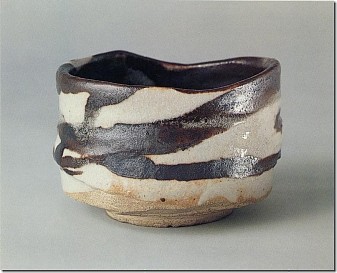
|
|
Above Photo
E-Shino Chawan by Matsuyama Suketoshi
Kanzaki's teacher, Master Matsuyama, emphasized in my interview with him the ultimate value of learning from failure.
|
|
|
"This is the important learning -- to know more than technique. In this way I open all secrets to my apprentices. To have a big heart is to open all secrets. And big hearts can make big works. And if my apprentices learn this important lesson, they will become successful at making their own works. And if they become successful, I do not hate or envy them. (To envy their success would be to have a small heart, and small hearts can make only small works.) No, to the contrary, I am very proud when my apprentices succeed in learning all my 'secrets.' I will have been, for them, the 'founder' of this way of working."
"I always try to teach my apprentices everything, to teach them to go beyond all that they have been taught, and to make works that come from their own heart and soul and spirit."
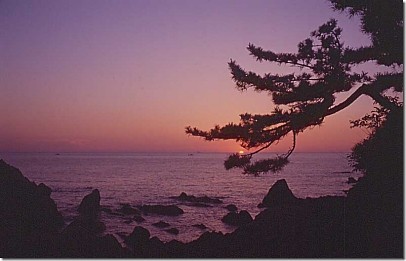
Sunset along the Echizen coast
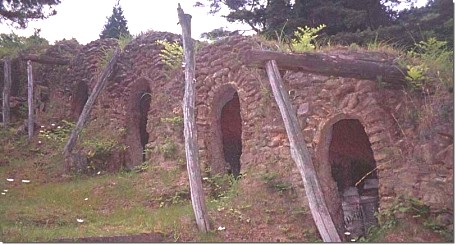
Old 11-Chamber Noborigama Kiln
Above story and photos by Dick Lehman
Copyright July 2002
All rights reserved
For more on Master Kanzaki, please visit:
1. Extending the Tradition
2. Moving Always in a Living Way
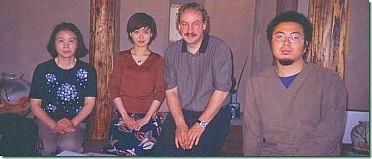
L to R: Michio's wife, Kazuya's wife, Dick, Kazuya
Dick Lehman is now working as technical editor for the Furutani Michio text Anagama: Building Kilns and Firing (now being translated into English). Click below for more on artist Furutani Michio.
Furutani Michio - King of the Anagama
|